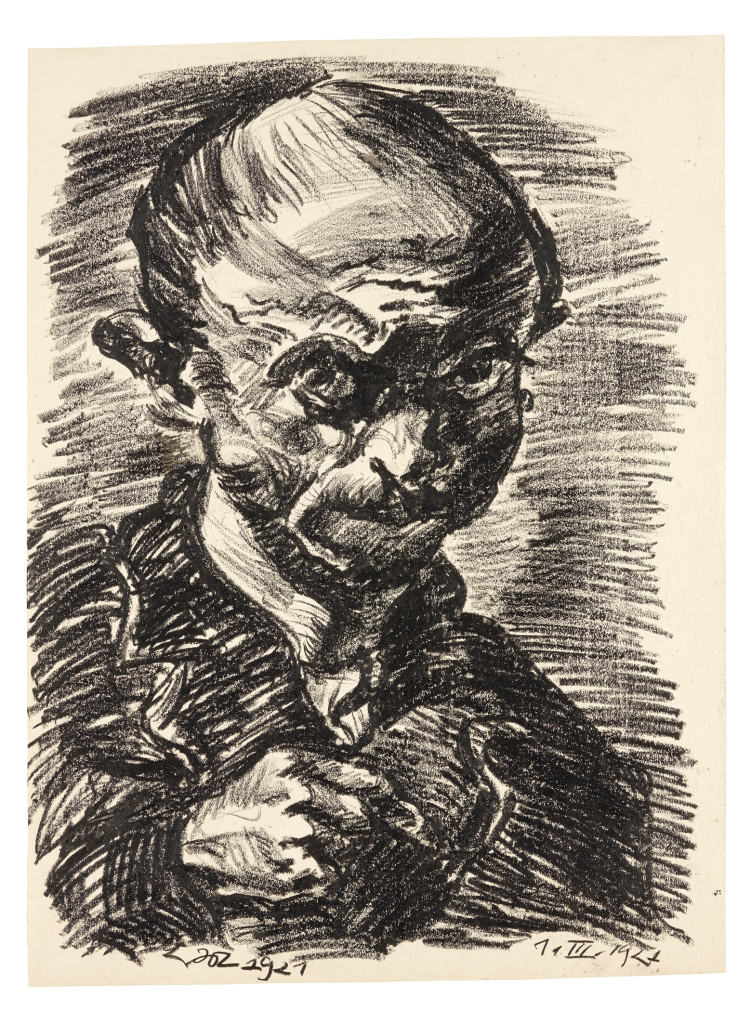Ludwig Meidner (Bierutów, formerly Bernstadt 1884 - 1966 Darmstadt)
Self-Portrait at Work, 1921
Grease crayon on paper, 63.7 x 47.5 cm
Monogrammed and dated lower left LM 1921, also dated lower right 1.III.1921
Provenance:
Peter Hopf, Berlin[1]
Private collection, England
Exhibited:
Tendenzen der Zwanziger Jahre. Die Novembergruppe, 15. Europäische Kunstausstellung, exhib. cat., Berlin, Kunstamt Wedding, Walther-Rathenau-Saal, Rathaus Wedding, Berlin 1977, no. 43, repr.
Ludwig Meidner’s extensive output of self-portraits is almost unmatched in twentieth-century art.[2] Throughout his artistic career he called himself into question, sought dialogue with his own mirror image and created a wealth of grandiose, harrowing and at times deeply disconcerting self-portraits. In these, as in his literary work, he repeatedly laid bare his soul in an intoxicating alternation of ecstatic experience, jubilation and sorrow.
Meidner’s depictions of himself are a thread running through his entire oeuvre. The earliest of these display typical academic characteristics and echoes of Jugendstil. The year 1912 brought a stylistic change in his work. Like his Apocalyptic Landscapes – unstable, disjointed, lurching cityscapes strongly influenced by Jewish and Christian mysticism – Meidner’s portraits and self-portraits are fragmented under the influence of Cubism and Futurism. Faces are distorted, heads deformed, hands crippled. Where colour is used, it is expressive and blazingly intense.
Not until the years around 1920 did Meidner’s extraordinarily dynamic style gradually become more restrained. It was during that period that he produced the two self-portraits presented here, both of which were executed in Berlin.
The originality and dynamism of Meidner’s art and poetry show him to have been an Expressionist of major importance. He produced a diverse and extensive oeuvre, not only as a painter, draughtsman and etcher, but also as a man of letters and a columnist.
After only two and a half years spent studying at the Art Academy in Breslau, Meidner moved to Berlin briefly in 1905. He spent the years 1906-7 in Paris, where he attended painting classes at two respected private art schools, the Académie Julian and the Atelier Cormo. But he soon abandoned formal training to spend hours on his own in the Louvre. His friendship with Amadeo Modigliani (1884-1920) dates from his stay in Paris.
From 1910 onwards, influenced by the works of Robert Delaunay, Meidner combined Cubist and Futurist elements with his strongly Expressionist style. He became known in Berlin for his Apocalyptic Landscapes, which seem to foreshadow the horrors of the World Wars, as well as for his self-portraits and his portraits of fellow artists working in Berlin.
During the First World War, Meidner served as a military interpreter in a prisoner-of-war camp. From the 1920s onwards, religious themes played a determining role in his art. His previously dynamic Expressionist style became more restrained and his draughtmanship, particularly in his works on paper, more intricate.
In 1935, to escape the increasing repression in Berlin, Meidner moved to Cologne to teach drawing at a Jewish school. In August 1939 he emigrated to England, where he and his family lived in straitened circumstances. It was only after he returned to Germany in 1953 that his work, which had fallen into oblivion after years of defamation, slowly regained recognition.
The self-portrait, executed in grease crayon, dates from March 1921. It is a compelling example of Meidner’s self-portraiture. With an intense, piercing gaze he scrutinizes his own reflection, a crayon gripped in his right hand.In terms of stance and expression, it has much in common with the watercolour but the use of grease crayon gives it an entirely different character. The dense, energetic swathes of parallel hatching, which are reminiscent of prints, appear in other Meidner drawings of the period.[3] Our self-portrait still displays the distortion and alienation characteristic of earlier works, expressed particularly in the striking contrast between Meidner’s diminutive hand and his huge head. However, the density of the lines results in a more finely differentiated facial expression. His features are firmer, in contrast to the self-portraits of the years around 1912, in which lines seem to burst explosively away from one another. Meidner now relies on different, less dramatic means to come to terms with his troubled emotional life. And those means, while equally merciless, are more complex than in the years around 1912.
[1] Peter Hopf (1937-2004) was a painter and stage designer. He ran the 'Kunstamt' in Wedding, originally a working-class district of Berlin. His collecting interests focused on the artists of the November Group, a group of expressionist artists and architects with left-wing political tendencies. Formed in Berlin in 1918, the group took its name from the month of the German Revolution (or November Revolution) of 1918-9. [2] See Gerda Breuer, Ludwig Meidner. Zeichner, Maler, Literat 1884-1966, exhib. cat., Darmstadt, Mathildenhöhe, 15 September-1 December 1991, Stuttgart 1991; Thomas Grochowiak, Ludwig Meidner, Recklinghausen 1966. [3] Compare Ludwig Meidner, Portrait of the Pianist Walter Kaempfer, 1920, grease crayon, Abraham Horodisch collection.

